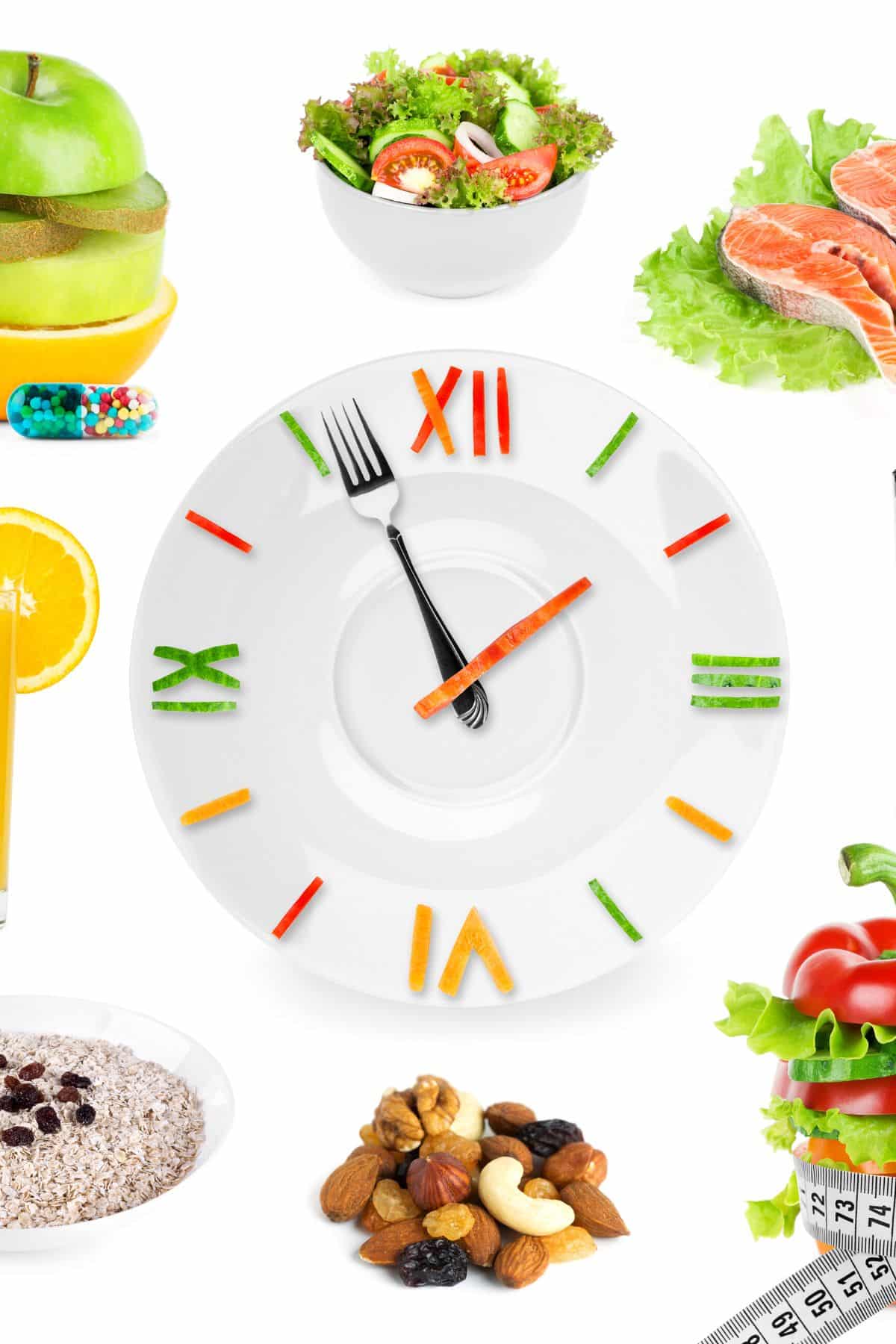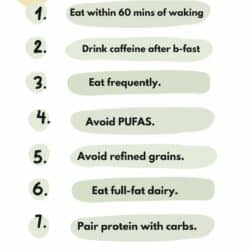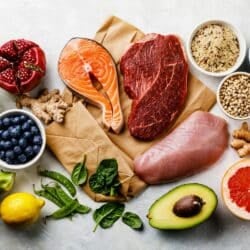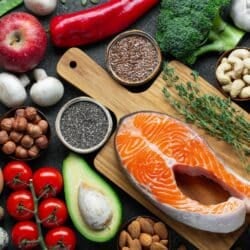How to Do the Metabolic Diet: 10 Tips to Get Started
If you are trying to improve your metabolism, you may want to consider following a Metabolic Diet. This type of eating plan is designed to help optimize your body’s metabolism and promote better overall health. Learn what a metabolic diet entails, as well as some general guidelines, pro metabolic foods, and what not to eat.

Overview of Metabolism
Put simply, metabolism is the process your body uses to convert the foods you eat into energy. It involves thousands of chemical reactions, all controlled by specific proteins.
The process begins when you eat and your digestive system uses enzymes to change the food into forms your body can use. Carbohydrates become simple sugars, fats become fatty acids, and proteins are broken down into amino acids.
These compounds are then absorbed by the blood and delivered to cells, where they can be used as sources of energy. Sometimes this energy is released for use, and sometimes it is stored to be used later. The tissues that store energy are mainly found in body fat, muscles, and the liver.
10 Tips for Starting a Metabolic Diet
1. Eating within an hour of waking
The thermic effect of food (the number of calories burned while your body digests and processes it – known as TEF) represents approximately 10% of your expenditure of calories.
TEF has been found to be at its highest in the morning, especially within the first few hours of waking. So to get the most benefit from this, it makes sense to consume more calories early in the day.
Eating within 60 minutes of waking up can also help with blood sugar control and signaling to your body that it is nourished and fed.
If you aren’t hungry when you wake up, try a small snack or even a small smoothie or mug of bone broth.
2. Avoid caffeine on an empty stomach
Caffeine can give your metabolism a boost and studies have shown that coffee can increase the metabolic rate by between 3 and 11%.
Most pro-metabolic experts emphasize that caffeine should not be consumed on an empty stomach.
Drinking coffee with an empty stomach (defined as two hours before or after you eat) is not recommended. This is because it may have a negative impact on blood sugar levels, not to mention the fact that it is also a common cause of acid reflux and can leave you feeling jittery.
If you can’t tolerate food in the mornings, then at least try a Protein Coffee to help add some nutrition early in the day. Or, go with my Herbal Coffee recipe or my list of the best Decaf Drinks at Starbucks to avoid caffeine altogether.
The point is that for a Pro Metabolic approach, you wait to consume any caffeinated beverages until after you have eaten breakfast.
3. Eat every 2-3 hours
Think of your metabolism as the fire that runs your body’s processes. You have to tend to your body’s fire with fuel (food). If you go too long without fueling your body, then the fire may dwindle.
Of course, portion control matters too and it would be counter-productive to eat large quantities of food every few hours. The aim should be to eat three main meals a day, plus two nutritious snacks. You may also want to incorporate an Adrenal Cocktail or two every day on a pro metabolic approach.
You may also want to try incorporate the Ray Peat Carrot Salad 1-2 times a day to help with your hormonal balance and digestive health.
For a list of healthy snacks, don’t miss my list of the best gluten-free and dairy-free snacks.
You may also want to check out my article on the dangers of intermittent fasting for women for more information on why women in particular need to eat often with enough calories to fuel energy levels and hormone balance.
4. Enjoy saturated fats and avoid too many polyunsaturated fats (PUFAs)
One rather surprising element of the pro metabolic diet is ditching polyunsaturated fats (PUFAs) in favor of saturated fats.
Although there is no real medical evidence to support it, the rationale is that saturated fats are more stable than polyunsaturated fats and have the necessary fatty acids to support the metabolism.
Polyunsaturated fats, on the other hand, are believed by some to actually slow down metabolism and put the brakes on fat burning. Foods high in polyunsaturated fats (and which may need to be avoided on a pro metabolic diet) include walnuts, flax seeds, fatty fish, and sunflower seeds.
Nutritious sources of saturated fats include coconut products like unsweetened coconut flakes and coconut oil, grass-fed meat, and grass-fed whole milk yogurt.
5. Avoid refined grains
The pro-metabolic diet endorses the avoidance of refined grains. That means cutting down on things like white bread, pizza, and pasta. Learn more about the potential health benefits of a grain-free diet for humans.
This is because refined grains take very little calorie expenditure to digest. The process of digesting whole grains, however, is more complex and your metabolism becomes a lot more active in the process.
Good examples of whole grains include whole oats, whole wheat (only choose foods labeled “whole wheat” rather than just “wheat”), buckwheat, barley, quinoa, and brown rice.
Note that not all whole grains will be suitable for everyone, as some – particularly wheat, barley, and rye – contain gluten. These would need to be avoided by anyone with a sensitivity to gluten, or those suffering from Celiac disease.
6. Enjoy dairy products, if tolerated
If you are not sensitive to them, good quality dairy products can play an important part in the pro metabolic diet. While medical research into the value of milk has not drawn any clear conclusions, it seems that foods like cheese and yogurt can be particularly beneficial to metabolic health.
A separate study found that people who consume lots of dairy products may even experience better fat oxidation and be able to consume more energy without a subsequent gain in weight, compared to those whose diets are low in dairy products.
7. Pair carbs with protein at every meal and don’t overdo fat sources
Protein has been shown to have a significant effect when it comes to boosting metabolism. That’s because the TEF (thermic effect of food) is greater after eating protein than other energy sources like fats and carbohydrates.
Studies have shown that eating foods high in protein can boost metabolism by an impressive 20 to 30%. A diet rich in protein also helps with the maintenance of muscle mass – another important factor in supporting a healthy metabolism.
Eating protein with your carbs rather than eating carbohydrates alone will also ensure a steady release of sugar into the bloodstream. This will prevent the “sugar crash” that is often associated with carb-rich foods.
While fats are another important nutrient, remember that many protein sources also contain fats. This means that you will need to take care that you are not consuming fats from too many other sources alongside your protein.
Some of my favorite protein-rich recipes include my Strawberry Protein Smoothie made with paleo protein powder, Overnight Protein Oats, Costco Stuffed Salmon, and Hibachi Shrimp with Yum Yum Sauce.
8. Prioritize sleep, stress management, and self-care
Did you know that poor sleep can disrupt your metabolism and increase your chances of gaining weight? Studies have shown that your metabolic rate may decrease by as much as 2.6% if you only average around four hours of sleep per night for five consecutive days.
Learning to manage your stress and take care of yourself are fundamental to getting a good night’s sleep. Explore different techniques to relieve stress, including exercise, deep breathing, meditation, yoga, and more.
You may also like my article with holistic health tips and natural ways to increase energy. I personally love to go for long walks and do some light pilates or yoga (see my article on pilates for beginners).
9. Take a “food first” approach to nourishing yourself and avoid unnecessary supplements.
Some vitamins – especially B vitamins and vitamin D – are essential for a healthy metabolism. While it can be tempting to reach for a supplement to increase your levels of these nutrients, the best option is to obtain them naturally from whole foods as part of a balanced diet.
This is because – in most cases – our bodies are better equipped to absorb nutrients from natural sources than they are from supplements. Furthermore, whole foods supply a wide variety of additional nutrients, fiber, and protective substances like antioxidants. They also prompt the digestive process, further boosting metabolism.
But, as always, be sure to speak with your doctor before stopping any supplements you may already be taking.
I am personally a big fan of supplements as they have so much evidence showing that they benefit health. See my related articles on the best vitamins for women over 30 and the best vitamins for women over 50.
10. Replenish your minerals either with real foods or mineral drops in your water
Calcium, iron, and magnesium are all important minerals when it comes to supporting metabolism. Ideally, you will obtain these minerals through a varied and balanced diet. But if you are worried that your diet isn’t supplying you with enough of these valuable nutrients, then you may want to consider adding minerals to your water, either in the form of drops, powders, tablets, or salts.
I personally take this electrolyte supplement that I add to my water. A lot of people in the pro metabolic world like these Trace mineral drops.
Learn more about an adrenal cocktail benefits.
What Can You Eat?
One of the best parts of Metabolic Eating or a Pro Metabolic Diet is that you can individualize it to your needs.
Here are some general guidelines for what to eat on a metabolic approach:
- Cooked vegetables
- Ripe seasonal fruits
- Raw carrots
- Eggs
- Whole dairy, if tolerated
- Fish and shellfish
- Liver and organ meats (can take a supplement)
- Coconut oil
- Butter or ghee
- Legumes, nuts, and seeds (all good sources of protein)
- Chili peppers (may help you burn 50 extra calories daily)
- Ginger (enhances the thermic effect of food)
- Apple cider vinegar (a good fat burner)
- Adrenal cocktail
And don’t overlook good old water! In addition to being essential for hydration, drinking water has been shown to boost metabolism by up to 30%!
Additional guidelines for what to eat to support a healthy metabolism include:
- Eat frequently, up to 5 times a day (3 meals and 2 snacks
- Choose organic foods when possible
- Avoid artificial sweeteners, additives, fillers, and chemicals
- Choose unprocessed foods as much as you can
- Cook your vegetables before eating, especially if you have a sensitive stomach
Foods to Avoid
On a metabolic diet, certain foods are typically avoided to optimize metabolism and promote health. These include highly processed foods, those rich in added sugars, and foods containing artificial additives.
Consuming such items might counteract the diet’s intention to boost metabolic health.
Foods to avoid:
- Highly processed and refined foods
- Foods and beverages with added sugars or artificial sweeteners
- Products containing artificial preservatives, colors, and flavors
- Too much caffeine, especially on an empty stomach
- Certain sources of saturated and trans fats
- Excessive amounts of alcohol
- Raw vegetables except carrots (if you have a sensitive stomach)
Potential Benefits
The benefits of a pro-metabolic approach will differ for everyone. And, remember that this way of eating may not be right for everyone either.
But, the potential pros or benefits of eating on a pro metabolic diet may include:
- Emphasis on Nutrient-Dense Foods: Pro-metabolic diets often promote the consumption of whole, unprocessed foods. This can lead to a higher intake of essential nutrients, vitamins, and minerals, which can enhance overall health and wellbeing.
- Potential Metabolic Boost: By aligning dietary choices with metabolic needs, this approach aims to increase metabolic rate. A higher metabolism can result in more efficient energy production, calorie burning, and even improved mood and mental clarity.
- Support for Hormonal Balance: Some proponents argue that by supporting the metabolism, the diet can help balance hormones, especially those related to stress and thyroid function, which in turn can have positive effects on mood, energy, and overall health.
- Encouragement of Mindful Eating: Many pro-metabolic diets emphasize the importance of listening to the body’s cues, fostering a healthier relationship with food and encouraging intuitive eating habits.
- Potential for Long-Term Lifestyle Changes: As the diet focuses on understanding and working with one’s metabolism rather than against it, it might promote long-lasting dietary and lifestyle changes rather than short-term fixes.
Potential Cons
There may be several drawbacks or even potential health risks of a pro metabolic approach. Some of these include:
- Potential for Nutritional Gaps: Tailoring a diet to perceived metabolic needs might inadvertently exclude essential nutrients or food groups, leading to nutritional deficiencies over time.
- Overemphasis on Metabolism: While metabolism is crucial, health and weight management are multifaceted. Over-focusing on metabolic rate can overlook other vital factors like genetics, environment, and emotional wellbeing.
- Risk of Disordered Eating: Overly restrictive or prescriptive diets can foster unhealthy relationships with food, potentially leading to or exacerbating disordered eating patterns such as obsession with certain foods, fear of others, or binge-eating behaviors.
- Concerns Regarding Food Allergies and Sensitivities: A notable drawback of some pro-metabolic diets is the potential inclusion of foods that might not be appropriate for individuals with food allergies or sensitivities.
- Limited Scientific Evidence: Many claims surrounding pro-metabolic diets, especially the more niche versions, may lack comprehensive scientific backing, making their long-term effects uncertain.
What is the Metabolic Rate?
This is the speed of your metabolism at the cellular level. Also known as calorie expenditure, it represents how many calories your body burns within a set amount of time.
There are actually various types of metabolic rates.
For example, your metabolic rate when you are sleeping or fully resting is known as your basal metabolic rate (BMR). Even though you may be at rest, there are still lots of reactions going on in your body to support your heart rate, your breathing, the maintenance of your body temperature, etc.
What Affects Your Metabolic Rate?
There are certain factors that can affect your rate of metabolism.
- Some hormonal disorders can slow your metabolism down. So can aging – partly because older people tend to move around less, but also because certain bodily functions become less efficient as we age.
- But there are other factors that can actually increase the metabolic rate. One of these is body size – larger people naturally burn more calories. The same effect is seen in people with a larger amount of muscle mass.
- Cold weather can cause an increase in metabolism, too, as the body burns calories in working to keep you warm.
- Most importantly, perhaps, your rate of metabolism is influenced by how much you move. There are even studies that show that just 45 minutes of vigorous activity can raise your metabolic rate for 14 hours – a real incentive to hit the gym or to be active.
- Plus, of course, a healthy, balanced diet – rich in nutrients – is essential for metabolic health.
Signs of Good Metabolism
People with a good metabolism tend to burn a lot of calories and are less likely to gain excess weight. In some cases, a fast metabolic rate can actually make it difficult for people to gain weight even when they want to.
Other indications of good metabolism include an increased appetite, a strong libido, and having lots of energy.
Signs of Poor Metabolism
Weight gain without intending to gain weight is one of the most obvious signs of poor metabolism. This extra weight often appears around the middle, especially in older people (hence the phrase “middle-aged spread.”)
A sluggish metabolism may also cause gas or bloating and hormonal imbalances – sometimes leading to dry skin or thinning hair. It may even trigger imbalances in blood sugar levels.
Other signs include a low sex drive, depression, insomnia, and a weakened immune system. People with a slow metabolism may also complain that they can’t lose weight no matter what.
FAQs
Like the paleo diet, the pro-metabolic diet includes plenty of fish, meats, vegetables, and seeds – foods that were once obtained from hunting and gathering (the principle that underpins paleo).
There is also a version of paleo known as the AIP Protocol (autoimmune paleo approach) that has been developed specifically to help reduce symptoms of autoimmune disease. See my article on the AIP Diet for Beginners.
The big difference between the two diets, however, is that the paleo diet excludes all grains – even whole grains – and dairy products, both of which are encouraged in the pro-metabolic approach.
Probably not. The pro-metabolic diet includes meat, fish, and products derived from animals. All of these are contrary to the principles of veganism, which excludes the exploitation or use of animals for food or any other purpose.
You can search for the term on Google, Instagram, or YouTube. Or, try this book How to Heal Your Metabolism: Learn How the Right Foods, Sleep, the Right Amount of Exercise, and Happiness Can Increase Your Metabolic Rate and Help Heal Your Broken Metabolism by Kate Deering.
Additional Resources
Because the pro metabolic diet is pretty new and doesn’t have a ton of science to support it, it can be hard to find quality resources to learn more. Here are a few trusted resources that I found:
- How to Heal Your Metabolism: Learn How the Right Foods, Sleep, the Right Amount of Exercise, and Happiness Can Increase Your Metabolic Rate and Help Heal Your Broken Metabolism by Kate Deering
- Hormone Healing RD Instagram account
- Jessica Ash Wellness Instagram account
- Real Food Gangstas Instagram account
More Helpful Articles About Nutrition and Health
Conclusions
The metabolic diet isn’t a “diet” in the sense that it restricts the amount of food you eat. Instead, it is more of a lifestyle approach that aims to harmonize the foods you eat with the way your body metabolizes them.
Eating in a way that supports metabolic function can have all sorts of advantages, from preventing weight gain to bringing your body back into balance. Not only is it important to achieve, but it is a great way to connect with your body and really understand the connection between your diet and good health.
Don’t forget to join my newsletter list to get exclusive clean eating recipes and tips. The newsletter is 100% free with no spam; unsubscribe anytime.
About the Author: Carrie Forrest has a master’s degree in public health with a specialty in nutrition and is a certified holistic nutritionist. She is a top wellness and food blogger with over 5 million annual visitors to her site. Carrie has an incredible story of recovery from chronic illness and is passionate about helping other women transform their health. Send her a message through her contact form.
Note: this post is for informational purposes only and is not intended as medical advice. Please consult your healthcare provider for recommendations related to your individual situation.






















Hi Carrie, great article although you may wish to double check the content in reference of how the elements of pro-metabolic living largely contributes the name from the work of Ray Peat’s and referenced by many Instagram advocates and Legumes, nuts, and seeds / PUFAS are definitely a no no, along with only fish from warm waters like the tropics not cold water fish like salmon etc. anywho really like your content just thought I’d throw in my five cents here 🙂
I love this article Carrie. THANK YOU!
I’m 63 and over the past two years haven’t been able to lose the extra 15 lbs I’m carrying. Despite eating clean. I do drink bulletproof coffee and intermittent fasting. But interesting read on drinking coffee on an empty stomach. Everything else I follow already.